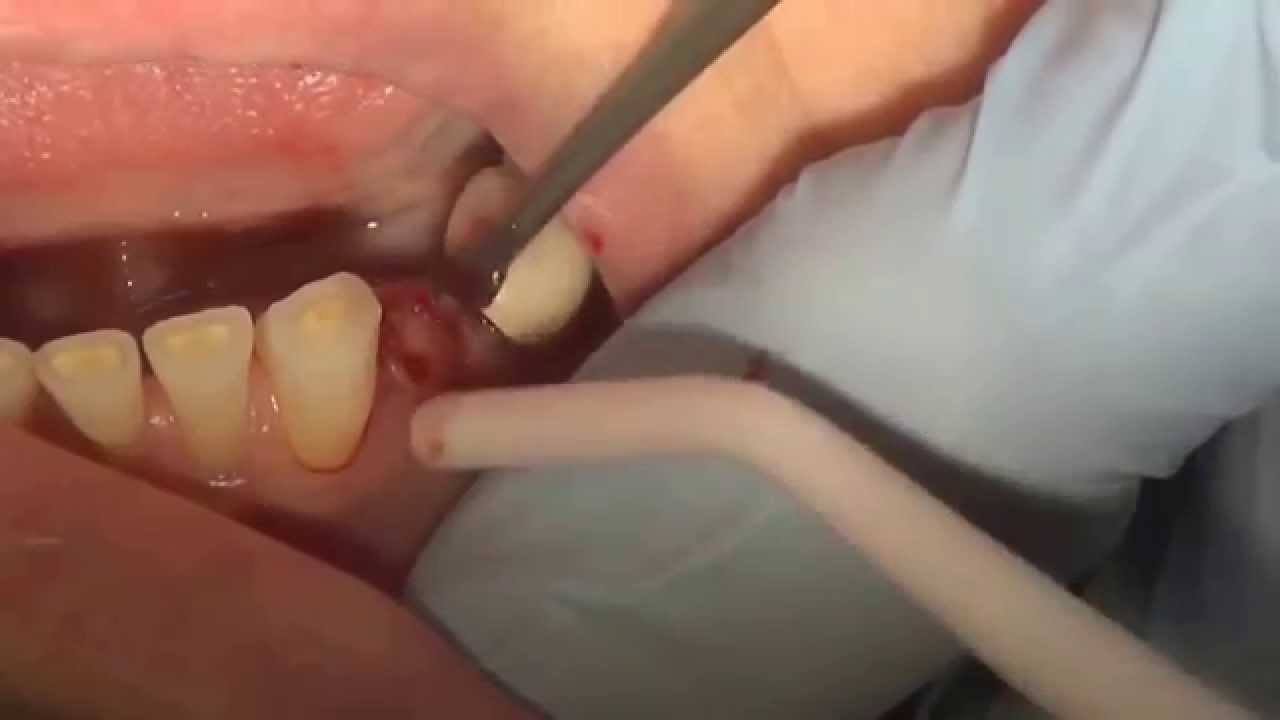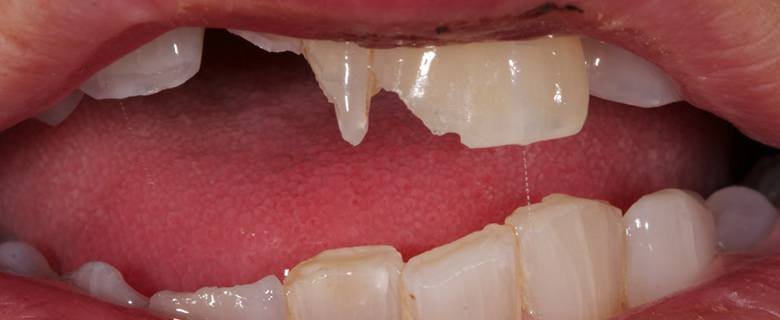So, what do you think happens when a tooth breaks?
Do you think you can live with it?
Well, you technically can, except it’ll haunt you by causing severe pain when biting and chewing…
Sensitivity to hot and cold stimulus as well as sweets
And providing a gateway for bacteria to cause swelling and infection which will eventually lead to abscess formation, which is a very painful collection of the pus.
Now, when it comes to broken teeth, they don’t just break the same way in every case.
Sometimes, it’s just the pointy cusp of the tooth that breaks off due to a minor accident like chewing on hard foods like ice. This can be well taken care of by a filling or just by reattaching the cusp.
But, if you’re someone who likes to take a mouthful of the hardest apple in the world or get in arguments and receive some amazing fist-blow-outs in return, your teeth may fracture in such a way that they cannot be saved.
In all such cases, your dentist will most likely decide to extract the tooth.
So How Do Dentists Remove Broken Teeth?

Because the thought of getting your teeth pulled out is such a scary one, let me ease it for you by telling you how dentists remove broken teeth.
It’s ideally an atraumatic process where your dentist will always start by injecting the area around the tooth with an anaesthetic, which will numb out all the sensations of the respective tooth and some other structures surrounding it.
After that, they will check if you are feeling any pricks by using a pointy dental instrument called ‘probe’.
Once your dentist is sure that you are unable to feel any kind of pain, the extraction will proceed. But, when it comes to pulling a tooth out, it requires a lot of expertise, unlike the concept that dentists pull the teeth out with a bunch of pliers while their patients cry of pain!.
There are two different types of extractions:
- Simple
- Surgical
When a tooth is above the gum line it can easily be taken out by the help of forceps, this is a simple extraction.
A surgical extraction, however involves removal of the gum tissue by perfectly cutting the gum and exposing the bone.
After that, the bone is removed by the help of a small and very cute drilling machine (used these words to undo the scary feels of the word drill), so that when the dentist finally puts the instruments in, the tooth can come out without any extra pressure or pain.
The surgical procedure is usually done in cases where the tooth is either completely or halfway embedded in the bone, the bone is coming in the way of instrumentation, or when the dentist fears that they will break the tooth, which is mostly the case in teeth that are already broken.
Hence, surgical extraction is the most common and trauma-free way to remove broken teeth.
Now let’s go ahead and find out some more facts about extracting broken teeth:
How Bad Does A Tooth Need To Be For Extraction

As I have already mentioned above, there are different ways in which a tooth breaks, it depends on the severity of the fracture in order to decide if it can be saved or not.
If it’s just the crown (visible part over the gum line) of the tooth that has broken down, it’s almost never extracted and can be saved by reattaching the broken tooth segment, doing a filling or replacing it by an artificial crown.
In cases where the crown of the tooth breaks in such a way that the pulp (the area of the tooth that contains all the blood vessels and nerves) is exposed, a root canal treatment is done in order to save the tooth. The broken crown is replaced by an artificial crown that looks exactly like the original tooth.
But in cases where the structure of the tooth is lost due to caries or tooth decay and the boundaries of the tooth are as such that a new crown cannot be attached, that tooth is usually extracted.
So if you have a cavity in any of your teeth, get it filled before it reaches the point of extraction.
Apart from that, in cases where the tooth breaks due to fracture and the breakage crosses the gum line, pulling that tooth out is the easiest option.
Once the tooth is out and the socket or wound is healed, your dentist will provide you with multiple options of replacement.
Please remember to follow suit, because if you leave that space empty, your bone will soon start reabsorbing and there will be a ditch in that area.
Along with that, the teeth that are around that socket will start moving in order to occupy the space, causing all your teeth to become haphazard and leading to an even bigger problem.
What Is The Cost Of Getting A Broken Tooth Removed?

If you are thinking of paying for your extractions from your pocket and don’t want to spend extra bucks for insurance coverage, here is a guideline for you.
Remember that if you have a proper dental care plan, it can greatly affect and lower your overall cost of dental care. So, here you go!
- $75 to $300 for non-surgical, tooth erupted extractions.
- $150 to $650 for a surgical extraction utilizing anaesthesia.
- $185 to $600 for complicated surgical extractions.
- $75 to $200 for wisdom tooth removal.
In the case of a broken fractured tooth, a surgical extraction is carried out, which can sometimes be complex.
However, if the tooth is broken due to tooth decay, non-surgical, tooth erupted extractions are the treatment of choice.
What Happens If A Dentist Leaves A Piece Of Tooth
Ideally your dentist will not leave any residues of the tooth that is being extracted.
However, when a tooth is already broken and while extracting the tooth, the root tip can become even more fractured.
with multiple failed approaches and the procedure becoming excessively painful for the patient, the dentists deliberately leave the root where it is.
But, it is only done in conditions when the root is really small and is deeply embedded in the bone or when any vital structures such as the inferior alveolar nerve (the nerve that provides sensations to both the teeth of the lower jaw, as well as the lips and the tongue) are surrounded by it and there is a risk of damaging them.
The final condition is when the tooth is not infected and there can be no infection seen on the X-ray around the root of the tooth.
In all such cases, the risks outweigh the benefits and leaving the root is a better suited option. It’s also highly unlikely that this root will cause any problem later.
However, the dentist should always inform their patient if they decide to leave a piece and keep a yearly record. Moreover, the patient should be instructed to contact their dentist immediately if they feel anything unusual.
Apart from that, when a root tip or a piece of a tooth is left within the socket for reasons other than mentioned above, or out of pure carelessness, it usually leads to the infection of the remaining root tip.
If the tip is sharp and visible, it may even hurt once the socket starts healing and the gum tissue starts to reattach. But this only happens once in a blue moon and most dentists are qualified enough to know better.
So, don’t you worry, just trust the doc!
Does It Hurt To Get Broken Teeth Removed?

May be in the 16th century it might have been a nightmare but now that the blessing of anaesthesia is here, extractions can be absolutely pain-free.
The only pain that you will experience is of the needle prick. After that, everything will go numb around that tooth and you’ll only feel the instruments touching your teeth.
However, when a tooth is being pulled out of its socket, the pressure that builds up with the back and forth movement of the tooth while the dentist tries to loosen it can be felt.
If a surgical extraction is being carried out, you may also feel some kind of vibration while the bone is getting drilled. But it’s nothing that you won’t be able to take.
So relax! No one is going to be jumping on the dental chair or crying of pain.
What To Do After A Tooth Extraction?
After a tooth extraction, your dentist will give you some post op instructions which are all very crucial to let the tooth socket heal faster with absolutely no complications.
So, note down these dos and don’ts that you have to follow after an extraction:
Do’s
- Keep the gauze that is used to pressure pack the socket for at least half an hour
- Eat soft, super cold ice-cream and make it touch the tooth socket or drink chilled water immediately after taking the pressure pack out
- Take the pain killers and antibiotics prescribed by your dentist
- Warm saline rinses multiple times a day after 24 hours of extraction. Continue doing so for the next 10 days
- Take a rest and don’t do any exercises for the next 24 hours
- Apply an ice pack on the side of the face where the surgery was performed
Don’ts

- Avoid eating anything solid or drink anything super-hot
- Don’t use a straw or gargle for the next 24 hours as it can cause the healing clot to dislodge from the socket, leading to some major complications
- Avoid smoking at least for the next few days
- Don’t poke on the socket, just let it be!
- Never take aspirin or ibuprofen for pain relief, as they are blood thinners and will prevent clot formation
- Don’t be afraid of a little swelling, as it’s all very normal!
The Final Pull
Having a broken tooth in and of itself is a nightmare with all that pain and discomfort. But getting the same tooth removed is like shaking hands with the monster under your bed that you’ve long been dreaming of.
However, it’s not all bad, and may even prove beneficial with all that jaw exercise if you have a double chin! Well, on a serious note, your dentist will simply numb the respective tooth and all areas surrounding it, so pain is not at all a problem.
Some pressure is expected
but what is it that a little patience can’t do?
Conversely, a broken tooth does not always lead to extraction and can even be saved by a filling or root canal therapy if it’s all above the gum line and the structure of the crown isn’t completely lost.
At times, even if the tooth needs to be taken out, it’s already so mobile in its own socket that the extraction becomes a piece of cake. At other times, when it’s as stubborn as a stone, a more extensive process of surgical extraction is carried out and the tooth is taken out via raising the gum tissue flap and drilling the extra bone.
In many instances, a tooth may break during extraction in such a way that a part of its root, called the root tip is left inside. When the risks of taking it out outweigh the benefits, the dentist usually decides to leave it there along with informing the patient and instructing them to get yearly follow ups.
Finally, when the tooth is extracted, a dentist always gives some post op instructions that are supposed to be followed religiously in order to avoid the formation of a dry socket, which is even more painful than having a broken tooth.
So, listen to what your dentist is saying, make sure to get a prosthetic tooth in place of the one being extracted (except for the wisdom teeth),
And avoid getting into fist-fights!
Related Post:
Is getting a root canal painful? – I’m Terrified!
